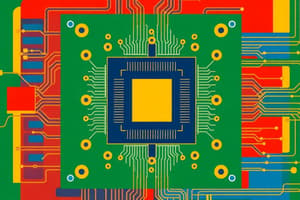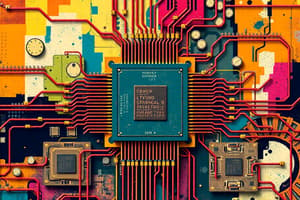Podcast
Questions and Answers
What is the name of the prominent mathematician who introduced the model for computer Architecture in the 1940s?
What is the name of the prominent mathematician who introduced the model for computer Architecture in the 1940s?
John von Neumann
What are the primary components of a CPU architecture?
What are the primary components of a CPU architecture?
- ISA
- Microarchitecture
- Registers
- All of the above (correct)
______ is a high-speed temporary memory storing unit present in the CPU.
______ is a high-speed temporary memory storing unit present in the CPU.
Registers
DRAM is faster and cheaper than SRAM.
DRAM is faster and cheaper than SRAM.
What are the three ways data transfer to peripheral and data transfer from the peripherals can be done?
What are the three ways data transfer to peripheral and data transfer from the peripherals can be done?
What is the purpose of Interrupt-initiated I/O mode?
What is the purpose of Interrupt-initiated I/O mode?
Direct Memory Access (DMA) allows peripherals to directly communicate with each other using the memory ______.
Direct Memory Access (DMA) allows peripherals to directly communicate with each other using the memory ______.
Study Notes
Computer Architecture
- The design of the internal workings of a computer system, involving decisions about the organization of the hardware, such as the instruction set architecture, data path design, and control unit design.
- Concerned with optimizing the performance of a computer system and ensuring that it can execute instructions quickly and efficiently.
Von Neumann Architecture
- Introduced by John von Neumann in the 1940s as a model for computer architecture.
- Consists of a Central Processing Unit (CPU), memory, and input/output devices.
- The CPU performs tasks such as executing instructions, doing mathematical operations, moving data, and making logical decisions.
Central Processing Unit (CPU)
- The main processor or central processor of the computer.
- Performs tasks such as executing instructions, doing mathematical operations, moving data, and making logical decisions.
- Components of the CPU include:
- Arithmetic and Logical Unit (ALU)
- Control Unit (CU)
- Registers
Instruction Set Architecture (ISA)
- An abstract layer that bridges the communication between computer hardware and software.
- Defines the operations that can be done by the hardware.
- Describes the registers, memory model, behavior of machine code, and data types.
- Examples of ISA include ARM, MIPS, and x86.
Microarchitecture
- The implementation of the Instruction Set Architecture (ISA).
- The ISA acts as the design specification in microarchitecture.
- The microarchitecture design process involves four stages: Fetch, Decode, Execute, and Write Back.
Memory Hierarchy
- The total memory capacity of a computer can be visualized as a hierarchy of components.
- The trade-off between performance and capacity.
- Consists of all storage devices contained in a computer system, from the slowest auxiliary memory to the fastest cache memory.
Memory
- A memory unit is a collection of storage units or devices that store binary information in the form of bits.
- Classified into two categories:
- Volatile Memory: loses its data when power is switched off.
- Non-Volatile Memory: permanent storage that does not lose data when power is switched off.
Registers
- A high-speed temporary memory storing unit present in the CPU.
- Can carry any type of information, including a bit sequence or single data.
- The number of bits in a register is called its width.
- Early computers had 8-bit registers, then 16-bit, 32-bit, and today many computers have 64-bit or more registers.
Cache Memory
- The data or contents of the main memory that are used again and again by the CPU are stored in the cache memory.
- The performance of cache memory is measured in terms of the hit ratio.
Main Memory
- Communicates directly with the CPU, auxiliary memory, and cache memory.
- The central storage unit of the computer system.
- Made up of RAM and ROM, with RAM integrated circuit chips holding the major share.
System Bus
- A group of lines that connect the CPU, memory, and I/O devices.
- Meant to carry information.
- Three types of buses: address bus, data bus, and control bus.
Computational Abstraction Layer
- Simplifies the execution of complex programs on large data sets.
- Build complex layers in a bottom-up approach.
I/O Techniques
- I/O devices can not be interfaced to a microprocessor directly.
- Need an I/O interface to communicate with external devices.
- I/O interface contains device selection logic, bus drivers, data buffers, status registers, and control lines.
- Mode of transfer: Programmed I/O, Interrupt-initiated I/O, and Direct Memory Access (DMA).
Studying That Suits You
Use AI to generate personalized quizzes and flashcards to suit your learning preferences.
Related Documents
Description
This quiz covers the fundamental concepts of computer architecture, including Von Neumann architecture, instruction sets, memory hierarchy, system bus, and I/O techniques. It tests your understanding of the internal workings of a computer system.




